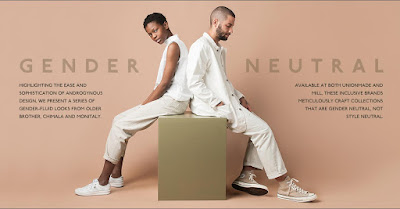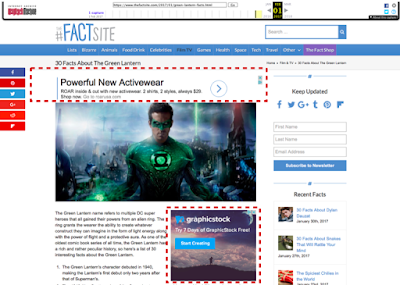[Hot] SEO 101: Website Design and Google's Latest Design Losers
Since we wrote about Google's recent algorithm update, "Fred," three weeks ago, certain sites have experienced dramatic changes in ranking. Search Engine Land reported this week on a fascinating study by Sistrix, "an SEO toolset data collection company," which revealed the big losers: ad heavy sites with "little or poor quality content, which had no value for the reader."
In one sense, the Sistrix study confirms what we already know: Google prefers sites that add value for the browser--and will penalize sites that seemingly focus on revenue generation to the detriment of content. Yet the study's findings also provide a nuanced view of how to design a Google-friendly website.
This nuance is especially valuable in light of Google's recent secrecy about the algorithm updates. Since the retirement of Matt Cutts, Google's former head of search quality, who had a congenial relationship with the SEO and digital marketing communities, Google has become decidedly tight-lipped about algorithm updates.
In fact, as Search Engine Land reported, Google's search engine leads decided not to talk about Fred, and would only confirm that the update targeted techniques documented in Google's Webmaster Guidelines.
So what does the Sistrix report tell us about Google-friendly website design? Content is key, of course, yet the way the content appears on the page is also crucially important.
Website Design: How to Impress Google
The term website design is often used interchangeably with website development, though design is a subset of development. People often refer to website design as the "front of the house" look and feel of a site, including the layout and graphics. Website development includes website design, yet also encompasses the "back of the house" work of coding, which makes a website secure and search engine friendly.
Of course, when design focuses on "look and feel," the result is often an attractive website. Unfortunately, attractive does not always translate to effective--especially if the design compromises the website's usability.
We often see attractive designs that fail at functionality. The use of Flash, which can be beautiful, yet can also make websites unruly, and worse, invisible to search engine "crawlers," is a perfect example.
In reality, SEO and "attractive" design are often incompatible. As Justin Taylor notes for Moz:
"The problem is simple. Websites that look amazing typically offer little opportunity for on-page optimisation and conversely pages that are well optimised will often compromise the design and user experience."
The key, as we see it, is to never compromise functionality in favor of beauty--and, as much as possible, to not compromise beauty in favor of excessive optimization.
So how do you design a SEO-friendly website? Focus first on how the website will appear to search engine crawlers. Your content must be rendered in a language the search engines understand.
"The easiest way to ensure that the words and phrases you display to your visitors are visible to search engines," Moz notes elsewhere, "is to place them in the HTML text on the page."
Additionally, you must present a streamlined website structure. As we noted in our post on website structure: "A good website is not simply a series of pages, but a carefully-plotted structure that describes, identifies, and classifies pages by topics and sub-topics."
Sound sexy? Perhaps not. But the world of search favors function over form. Speed and efficiency are more important than beauty. Yes, you can have both, but all is lost if browsers cannot access your content quickly and easily.
Other factors of SEO-friendly design, including meta tags and title tags, for example, assure that a website performs its essential role--to communicate information.
Fred: What We Learn About Design from Google's Latest Algorithm Update
Google's latest algorithm update has penalized ad-heavy sites--specifically sites that place ads "above the fold"--a phrase that describes the content visible to a browser without scrolling down the page. Ideally, a website will offer content before ads, above the fold, yet many ad-heavy websites do the opposite. As Colt Ager notes for The Tech Reviewer:
"Understanding what 'above the fold' means is a basic, but critical component in web design. You want to be sure to design your website around this concept with your best and most appealing attributes shown in this area to entice readers to continue to scroll down to the content below the fold."
So your content above the fold should inspire a browser to scroll below the fold. Above the fold ads often inspire browsers to click away. The Sistrix study cites the case of Thefactlist.com, which lost 50% of its traffic post-Fred on Google UK. The layout before the update shows an ad-heavy page with two AdSense ads above the fold:
As Sistrix notes: "Thefactsite.com seems to have quickly noticed the loss in rankings and made the decision to decrease their ads presence, above the fold. When we take a look at their layout today, there is only one ad block and their Visibility Index this week managed to recover."
The design lesson here is clear, and confirms what the essential view we confirmed above: Google prefers sites that add value for the browser--and will penalize sites that seemingly focus on revenue generation to the detriment of content.
Of course, Google understands that websites must monetize, yet again, not to to the detriment of the content. And this is the essential point of Google-friendly website design: Prioritize user experience, in terms of content, usability, and speed. Otherwise, all attempts at monetization may be doomed to failure.
An SEO Company That Understands Website Design: Stepman's SEO!
To build an effective, fully-optimized website, you need a web design and development company that understands SEO. Stepman's SEO is the rare company that offers a host of SEO and marketing professionals to optimize your website. Contact Stepman's SEO today to learn how you can improve your website's performance: 215-900-9398.
In one sense, the Sistrix study confirms what we already know: Google prefers sites that add value for the browser--and will penalize sites that seemingly focus on revenue generation to the detriment of content. Yet the study's findings also provide a nuanced view of how to design a Google-friendly website.
This nuance is especially valuable in light of Google's recent secrecy about the algorithm updates. Since the retirement of Matt Cutts, Google's former head of search quality, who had a congenial relationship with the SEO and digital marketing communities, Google has become decidedly tight-lipped about algorithm updates.
In fact, as Search Engine Land reported, Google's search engine leads decided not to talk about Fred, and would only confirm that the update targeted techniques documented in Google's Webmaster Guidelines.
So what does the Sistrix report tell us about Google-friendly website design? Content is key, of course, yet the way the content appears on the page is also crucially important.
Website Design: How to Impress Google
The term website design is often used interchangeably with website development, though design is a subset of development. People often refer to website design as the "front of the house" look and feel of a site, including the layout and graphics. Website development includes website design, yet also encompasses the "back of the house" work of coding, which makes a website secure and search engine friendly.
Of course, when design focuses on "look and feel," the result is often an attractive website. Unfortunately, attractive does not always translate to effective--especially if the design compromises the website's usability.
We often see attractive designs that fail at functionality. The use of Flash, which can be beautiful, yet can also make websites unruly, and worse, invisible to search engine "crawlers," is a perfect example.
 |
| Certain fashion websites are notorious for offering beautiful designs that sacrifice functionality. Unionmade's site, while beautiful, is often derided for its poor functionality. |
"The problem is simple. Websites that look amazing typically offer little opportunity for on-page optimisation and conversely pages that are well optimised will often compromise the design and user experience."
The key, as we see it, is to never compromise functionality in favor of beauty--and, as much as possible, to not compromise beauty in favor of excessive optimization.
So how do you design a SEO-friendly website? Focus first on how the website will appear to search engine crawlers. Your content must be rendered in a language the search engines understand.
"The easiest way to ensure that the words and phrases you display to your visitors are visible to search engines," Moz notes elsewhere, "is to place them in the HTML text on the page."
Additionally, you must present a streamlined website structure. As we noted in our post on website structure: "A good website is not simply a series of pages, but a carefully-plotted structure that describes, identifies, and classifies pages by topics and sub-topics."
Sound sexy? Perhaps not. But the world of search favors function over form. Speed and efficiency are more important than beauty. Yes, you can have both, but all is lost if browsers cannot access your content quickly and easily.
Other factors of SEO-friendly design, including meta tags and title tags, for example, assure that a website performs its essential role--to communicate information.
Fred: What We Learn About Design from Google's Latest Algorithm Update
Google's latest algorithm update has penalized ad-heavy sites--specifically sites that place ads "above the fold"--a phrase that describes the content visible to a browser without scrolling down the page. Ideally, a website will offer content before ads, above the fold, yet many ad-heavy websites do the opposite. As Colt Ager notes for The Tech Reviewer:
"Understanding what 'above the fold' means is a basic, but critical component in web design. You want to be sure to design your website around this concept with your best and most appealing attributes shown in this area to entice readers to continue to scroll down to the content below the fold."
So your content above the fold should inspire a browser to scroll below the fold. Above the fold ads often inspire browsers to click away. The Sistrix study cites the case of Thefactlist.com, which lost 50% of its traffic post-Fred on Google UK. The layout before the update shows an ad-heavy page with two AdSense ads above the fold:
 |
| Source: Archive.org via Sistrix.com |
 |
| Source: Archive.org via Sistrix.com |
The design lesson here is clear, and confirms what the essential view we confirmed above: Google prefers sites that add value for the browser--and will penalize sites that seemingly focus on revenue generation to the detriment of content.
Of course, Google understands that websites must monetize, yet again, not to to the detriment of the content. And this is the essential point of Google-friendly website design: Prioritize user experience, in terms of content, usability, and speed. Otherwise, all attempts at monetization may be doomed to failure.
An SEO Company That Understands Website Design: Stepman's SEO!
To build an effective, fully-optimized website, you need a web design and development company that understands SEO. Stepman's SEO is the rare company that offers a host of SEO and marketing professionals to optimize your website. Contact Stepman's SEO today to learn how you can improve your website's performance: 215-900-9398.